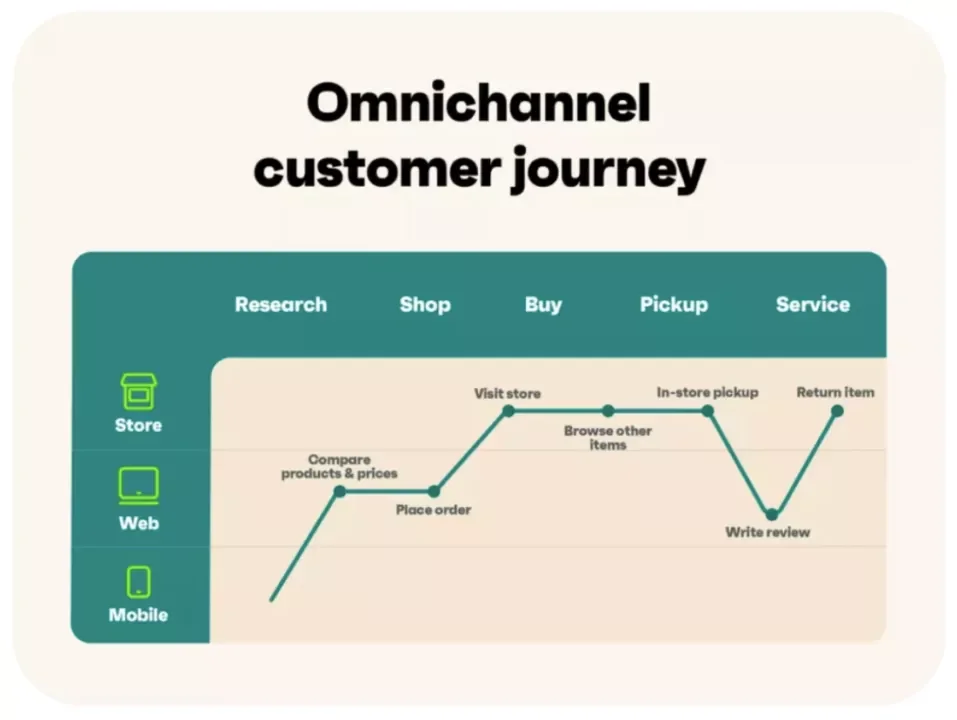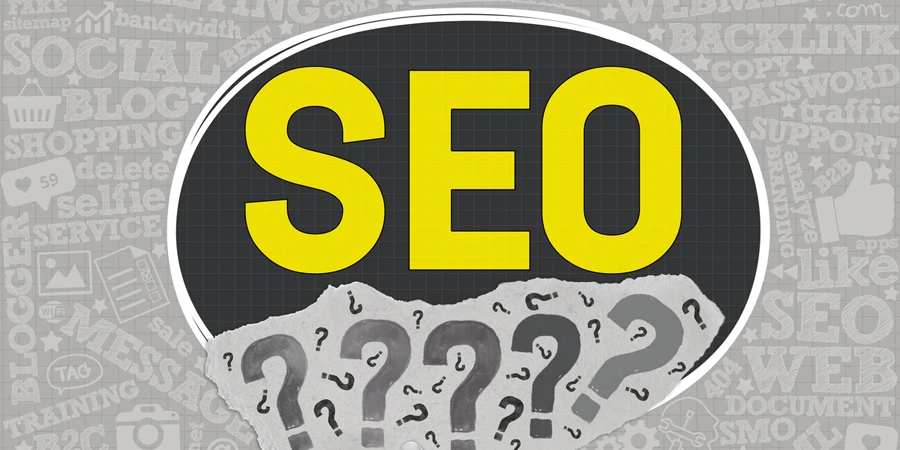What is omnichannel commerce?
Omnichannel commerce is the seamless integration of multiple channels at once. It creates a personalized customer experience with consistent messaging throughout the buyer’s journey.
Omnichannel commerce differs from single-channel and multichannel commerce.
As the name suggests, single-channel commerce uses only one channel. Multichannel commerce uses several marketing channels, but these channels don’t always pay attention to each other.
A customer may receive an email and SMS that say the same thing, whereas an omnichannel approach ensures the different channels complement each other. For example, sending an SMS that tells the customer there’s a discount code in their email inbox.
The impact of omnichannel is clear. Omnisend research found that marketers using three or more channels in a campaign earned a 494% higher order rate than those using a single-channel campaign. Furthermore, McKinsey discovered that omnichannel customers shop 1.7 times more frequently than single-channel shoppers.
In the next sections, we’ll dive deeper into why omnichannel commerce is important. We’ll also cover how to develop a good strategy and tips for success.
Why is omnichannel commerce important for your business?
Creating an omnichannel customer journey is vital to meet changing customer expectations. Here are the advantages of such a strategy:
- Enhanced customer experience: Omnichannel provides a seamless, personalized experience across channels. This helps customers feel valued.
- Increased sales and traffic: Using multiple channels expands your reach and can increase the number of orders you receive.
- Boosted customer loyalty: A consistent experience builds trust and keeps customers coming back, leading to a higher lifetime value.
- Better data collection: Omnichannel gives you a 360-degree view of customer behavior. This can help your team make smarter marketing decisions.
The customer journey is becoming more complex. Businesses that adjust to omnichannel will be well-positioned to drive engagement and revenue.
A Statista report places global ecommerce sales at $5.8 trillion in 2023, with estimates that they will surpass $8 trillion by 2027.
By failing to adapt, brands may lose out to competitors offering what customers now expect.
Do you need to have an omnichannel commerce strategy?
In short, yes. Customers largely expect it, and the research is clear that it can help to increase sales and loyalty. Brands that don’t adapt are likely to lose customers to those that do.
Kinsta found that multichannel shoppers spend three times as much as single-channel shoppers. The great news is that omnichannel commerce is achievable for businesses of all sizes.
With the right tools, you can turn casual browsers into loyal customers. Even small changes in the customer experience can improve sales and retention.
5 tips for building your omnichannel commerce strategy
Ready to get started with omnichannel commerce? Here are five key tips to keep in mind as you plan your strategy:
1. Use cross-channel messaging
Engaging customers across different channels is the basic principle of omnichannel commerce. Email and SMS are two powerful owned channels to leverage. With them, you can deliver timely, personalized messaging throughout the customer journey.
As you map out your customer journey, identify key touchpoints where email and SMS can add value.
For example, you can send a welcome email when someone subscribes and if they haven’t opened the email within 24 hours, send them a reminder via SMS.
Abandoned cart emails and SMS marketing can recover lost sales. Post-purchase messages can cross-sell related products and request reviews.
Here are some more things to keep in mind as you develop your cross-channel messaging:
- Understand each of your channels. Collect and use the data you gather to craft your unique messaging.
- Be strategic with timing and tone. Align the frequency of your messages with the stage that customers are currently in.
- Choose the right channels to use in your omnichannel strategy. For example, emails are great for newsletters and personal offers, but SMS is best for quick updates.
2. Keep branding consistent
Consistent branding across channels is essential for creating a cohesive customer experience. Your website, social profiles, emails, ads, and in-store signage should all be similar.
A consistent look and feel across channels builds brand recognition and trust. Set clear brand guidelines to outline visual identity, voice, tone, and key messaging.
Establish color palettes, typography, image styles, and examples of on- and off-brand content. Ensure stakeholders have access to these guidelines and understand how to apply them.
Run regular audits to check for inconsistencies and update any outdated assets. Make sure your logo is high-resolution, links work, and messaging is consistent. Even small discrepancies can make your brand appear less credible.
All your communications should reinforce your value proposition and brand promise. Develop a content strategy that aligns with your brand identity, and keep the voice consistent across channels while showcasing your brand personality. This is what sets you apart from competitors.
3. Focus on mobile optimization
Mobile commerce is massive and growing. Insider Intelligence expects retail mobile commerce sales to double between 2020 and 2025.
Globally, mobile commerce sales reached $3.56 trillion in 2021, so it’s essential that all your digital channels provide a personalized user experience on mobile devices. Use responsive design on your website to ensure it looks great and functions well on any screen size.
You should also streamline your mobile checkout process by eliminating unnecessary steps, allow auto-fill when possible, and offer payment options like Apple Pay and Google Pay.
Your email design should also be mobile-friendly. People open more than half of all emails on mobile devices. Use a single-column layout, large text, and touch-friendly buttons.
Keep your subject lines short and put the most important content at the top of the email. Always test your emails on different devices before you hit “Send.”
SMS is inherently mobile-friendly, but there are still best practices to follow. Keep your messages concise (160 characters or less) and include a clear call to action. Use SMS for time-sensitive alerts, like order confirmations, shipping updates, and flash sales.
Keep in mind that you can connect SMS to other channels, too. For instance, it can be used to boost email signups or remind customers about abandoned carts.
4. Focus on personalization
Personalization is key to omnichannel commerce success. McKinsey found that 71% of consumers expect personalization, and 76% get frustrated when they don’t find it.
Personalized experiences make customers feel valued and understood. Collect data for a better understanding of customer preferences and behavior.
Consider your ecommerce platforms, email marketing automation, touchpoints, customer service, and social media.
Segment audiences based on demographics, purchase history, browsing behavior, and other relevant criteria. Then, tailor the messaging and offerings to each segment.
This could mean:
- different email campaigns for first-time buyers versus loyal customers
- different product recommendations to men versus women
- special offers to customers who haven’t bought in over 6 months
For example, if a customer abandons their shopping cart, you can trigger an automated email reminding them of the items they left behind. This email could show them what they’ve left and offer a limited-time discount code to encourage them to complete the purchase.
Alternatively, when a customer makes a purchase, you can display a popup message on your website thanking them for their order and suggesting complementary products they might like.
By tailoring your messages to the customer’s actions and interests, you create a more engaging and relevant experience that can boost loyalty and drive additional sales.
5. Provide a seamless customer experience
Customer service is an often overlooked but critical part of omnichannel commerce. No matter how customers contact you, they deserve prompt, knowledgeable, and consistent support.
Provide support for your customer service team with a complete view of each customer’s history across channels. Past purchases, interactions, and preferences can help to provide more personalized support.

Integrate a customer service platform with your other systems so data is always current and correct. These can be your ecommerce platform and marketing automation apps.
Create self-service options, like FAQ pages, how-to videos, and AI chatbots. These can help resolve common issues and reduce the burden on your support team.
Make sure these resources are easy to find and use. Keep them updated based on customer feedback.
Always request feedback after each interaction through surveys or follow-up emails. Track social media sentiment and address any negative comments or reviews ASAP.
Respond to all feedback to show customers you value their input. You can also share positive testimonials across your marketing channels as social proof.
Ensure your support team is knowledgeable about your products, policies, and brand voice. Assess service metrics like response times and satisfaction scores regularly. Always look for ways to keep improving.
Wrap up
Omnichannel commerce is extremely effective when it comes to meeting customer expectations and driving business growth. It combines cross-channel messaging, consistent branding, mobile optimization, personalization, and exceptional customer service.
Here are some key takeaways:
- Omnichannel commerce is the seamless integration of multiple channels to create a personalized experience with consistent messaging.
- Omnichannel commerce leads to increased sales, traffic, and loyalty, and provides better data collection for marketing decisions.
- Customer behavior is shifting towards omnichannel engagement.
- Brands need to adapt to stay competitive.
Implementing these strategies can help businesses provide a seamless and personalized experience for customers, ultimately driving engagement and revenue growth.
Source from Omnisend
Disclaimer: The information set forth above is provided by omnisend.com independently of Alibaba.com. Alibaba.com makes no representation and warranties as to the quality and reliability of the seller and products.







